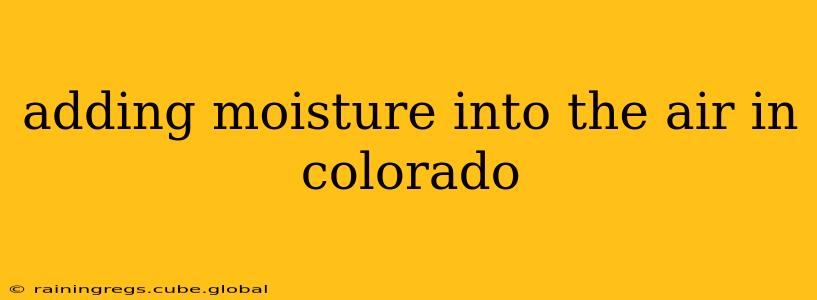Colorado's famously dry climate, while offering stunning scenery and abundant sunshine, presents a unique challenge: maintaining comfortable humidity levels indoors. The low humidity can lead to dry skin, irritated respiratory systems, and even damage to wooden furniture. This comprehensive guide explores effective ways to add moisture to the air in your Colorado home, addressing common concerns and providing practical solutions.
Why is Humidity so Low in Colorado?
Colorado's arid climate stems from its high altitude and geographic location. The air is thinner at higher elevations, meaning it holds less moisture. Furthermore, the state's distance from large bodies of water limits the natural humidity levels. This dry air is exacerbated during winter months by cold, dry winds. Understanding the root cause helps in selecting the appropriate humidification methods.
What are the Best Ways to Add Moisture to the Air in Colorado?
Several methods effectively increase humidity in Colorado homes. The best choice depends on your budget, home size, and personal preferences.
1. Humidifiers: A Popular Choice
Humidifiers are the most common and effective way to add moisture to the air. There are several types available:
-
Evaporative Humidifiers: These are generally affordable and energy-efficient. They work by drawing water into a filter, where it evaporates into the air. Regular cleaning is crucial to prevent mold and bacteria growth.
-
Ultrasonic Humidifiers: These use high-frequency vibrations to create a fine mist. They're quiet and efficient but require regular cleaning to prevent mineral buildup.
-
Steam Humidifiers: These boil water to create steam, effectively increasing humidity. They're great for larger spaces but consume more energy and require careful monitoring to avoid burns.
2. Houseplants: A Natural Approach
Certain houseplants naturally release moisture into the air through transpiration. While not as impactful as a humidifier, strategically placing moisture-loving plants around your home can contribute to a slightly more humid environment. Examples include peace lilies, spider plants, and snake plants.
3. Boiling Water: A Simple, Temporary Solution
A simple, temporary solution for adding moisture is to boil a pot of water. The steam released will add some humidity to the immediate area, offering temporary relief. However, this isn't a sustainable long-term solution.
4. Airtight Containers: Preventing Moisture Loss
Minimizing moisture loss is equally important as adding moisture. Ensure your home is properly sealed to prevent dry air from entering and moist air from escaping. Check for drafts around windows and doors, and consider weatherstripping if necessary.
How Much Humidity is Ideal for a Colorado Home?
The ideal humidity level for a Colorado home is typically between 30% and 50%. Levels below 30% are considered too dry, while levels above 50% can contribute to mold and mildew growth. A hygrometer is a useful tool for monitoring humidity levels.
What are the Health Benefits of Increasing Humidity in Colorado?
Adding moisture to the air offers several health benefits:
-
Relief from Dry Skin and Irritated Respiratory Systems: Dry air exacerbates conditions like eczema and asthma. Increased humidity can soothe dry skin and alleviate respiratory irritation.
-
Improved Sleep Quality: Dry air can disrupt sleep. A more humid environment can lead to better sleep.
-
Protection of Wooden Furniture: Low humidity can cause wooden furniture to crack and dry out. Adding moisture helps preserve its quality.
How Often Should I Clean My Humidifier?
Regular cleaning is crucial for preventing the growth of mold, mildew, and bacteria in your humidifier. Follow the manufacturer's instructions for cleaning, but generally, you should clean your humidifier at least once a week.
Can Over-Humidifying Cause Problems?
Yes, over-humidifying can lead to mold and mildew growth, which can negatively impact your health. Always monitor humidity levels with a hygrometer and ensure proper ventilation.
This guide offers a comprehensive overview of adding moisture to the air in Colorado. Remember to choose the method that best suits your needs and always monitor humidity levels to maintain a healthy and comfortable home environment.
